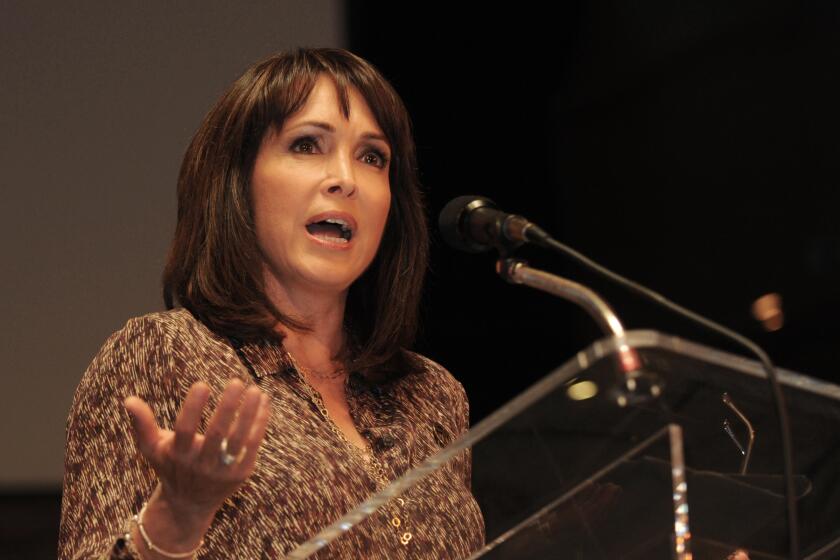Descriptive TV--Progress Report on Video for the Blind
- Share via
Imagine: You are watching a suspenseful television movie, an old-fashioned whodunit. The tension builds, and well-crafted dialogue carries you along. The identity of the villain is about to be revealed.
But the picture goes out on your television set. And because this is a silent scene, perhaps with the murderer slinking into a room or coming out from behind a curtain, the dialogue drops out at the same time.
For 11 million visually impaired Americans, the scenario is frustratingly familiar. It happens nearly every time they turn on the tube.
But slowly, the picture is changing.
Just as captioning made television accessible to millions of hearing-impaired people, new techniques for narrative or descriptive television hold out hope for those who are blind and partially sighted.
It’s been just one year since the Public Television Service debuted what it calls its “Descriptive Video Service,” or DVS. Produced out of public-television station WGBH in Boston, the service consists of narrations that describe the events, characters and silent scenes in the PBS series “American Playhouse” and “Mystery” and “Wonderworks Family Movie.”
“It’s wonderful. It gives us access to TV,” said Stan Greenberg, executive director of the Westside Center for Independent Living. “Television is a visual medium, and people who can’t see need some accommodation.”
PBS is not the only organization working to bring descriptive television to the blind. The Tulsa, Okla.-based Narrative Television Network has been writing and recording scripts to classic movies since 1989, and in the last year has seen its versions of great films carried on 800 cable television systems nationwide. The films run mostly on the Nostalgia Channel, although some cable systems run them on local channels.
“I’m blind myself, and lost the remainder of my sight three years ago,” said Jim Stovall, who founded the company. “After I lost my sight, I had a very frustrating experience sitting down to listen to a tape of an old Bogart film. I had seen it so many times that I thought I could follow it, but about halfway through I lost the plot. Somebody shot somebody else, and I couldn’t figure out what had happened.”
Stovall’s technique is fairly simple: His company writes and records narrations, which are then spliced onto videotapes along with the classic film being described.
But that creates a problem for sighted viewers, who may not want to hear the narrations.
PBS’ technique is more subtle. It relies on a third, little-used audio channel that was originally built into stereo television sets to carry foreign-language translations to English programs.
“It’s a separate audio channel, parallel to the regular audio channel,” said Laurie Everett, who runs the descriptive service for PBS. It can be carried on any station, as long as the broadcaster has the ability to send audio signals on three different channels. Receiving the signals, however, requires a stereo television set.
“What I’m understanding with a year of this under my belt is that what we’re doing is providing much more than television,” Everett said. “Blind people tell us that in describing a drama, we have added to their cultural literacy. We have decoded body language and gestures and explained how people communicate nonverbally. We have added to their knowledge of arts. We have helped them socially.”
Teen-agers “watching” narrated programs have even learned about clothing fads from the service, which won a special Emmy for public service last fall, Everett said.
WGBH got the idea for descriptive video from the work of Margaret and Cody Pfanstiehl, whose company, Washington Ear, had been providing narrations of plays at theaters in Washington, D.C., and other cities. The Pfanstiehls’ method involved a narrator, whose live descriptions of the action was carried to visually impaired theatergoers on wireless headsets.
The first attempts at narration for television were fairly crude, Margaret Pfanstiehl acknowledged, but they worked.
“ ‘American Playhouse’ sent us videocassettes in advance,” Pfanstiehl said. “We recorded descriptions, and 18 radio reading services agreed to broadcast them simultaneously. You would tune into the radio while watching the program.”
Pfanstiehl, who is visually impaired, said that television provides a lifeline to the rest of American society that sighted viewers might not understand.
“This isn’t something frivolous,” Pfanstiehl said. “For congenitally blind people who have little or no knowledge of body language, they are just constantly amazed at all the visual things that go on.”
But despite early success on PBS, and Stovall’s forays into films, it will most likely be a long time before descriptive video becomes commonplace.
At PBS, the growth of the service is hampered by financial constraints. The original grants that funded it only provide enough money to describe “Mystery,” “American Playhouse” and “Wonderworks,” said Everett, and fund-raising for additional efforts has been particularly slow.
The commercial networks say they are not equipped to broadcast the third audio channel required to carry the descriptions, according to network spokesmen.
But for the blind, the two existing services are reason enough to celebrate. “I made a donation to KCET thanking them for descriptive video,” said Greenberg. “Now I can appreciate what the deaf have with their captions.”
More to Read
The complete guide to home viewing
Get Screen Gab for everything about the TV shows and streaming movies everyone’s talking about.
You may occasionally receive promotional content from the Los Angeles Times.






